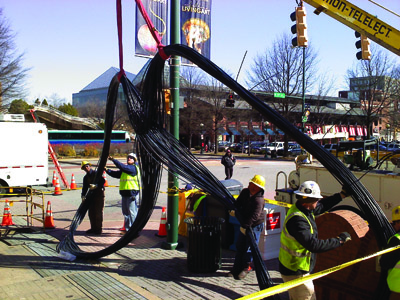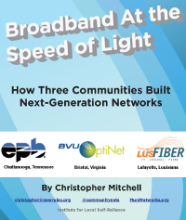
Fast, affordable Internet access for all.

Investors don’t think too highly of the company either. Charter reported a wider third-quarter loss in November, losing $87 million compared with $85 million lost during the same quarter last year. Executives tell Wall Street the company was in chaos before new management under Tom Rutledge took over operations. Rutledge’s priorities are to invest in new set top boxes, convert more of its systems to digital, raise prices on services, cut back on promotions and retention offers, and centralize customer support operations.Imagine that! When communities have to make investments and suffer losses, they are accused of failing. Charter is losing money (and recently emerged from a bankruptcy proceeding) and trying to make changes to correct its condition. This is what happens to many firms in telecommunications. Only when it happens to those that are owned by communities, they are besieged with claims that such a situation is somehow proof that the public cannot own and operate networks. Note that others, like Comcast, are actually lauded by Wall Street for operating in areas with so little competition that they can increase their rates at will -- hard not to make a profit in that case. Which is precisely why existing cable and DSL companies push laws to restrict local authority to build better networks.
Last year, we reported that ECFiber was in the process of connecting rural Vermont, with a focus on connecting those who had no access to broadband. In addition to large investments from a limited number of investors, local citizens began lending funds to expand the network.
In a recent open letter to the Governor, published in the Barre Montpelier Times Argus, Laura Zantzinger from Barnard describes how ECFiber touches her household. Zantzinger's home tech company can now expand because she has the capacity she needs from ECFiber. Zantzinger also discusses how fiber access helps her son academically:
My son attends an online high school in a program offered through one of the top universities in the country. He attends video conference classes, lectures, meetings, and myriad other communications online to California, and places all over the globe.
Two years ago, we moved out of state, renting a house elsewhere to get the Internet, because my son was not able to participate in class. His grades suffered because of it. Last year, we rented an office in another town where Internet was available.
Zantzinger describes two growing trends - home based businesses and distance learning - that require access to broadband. Zantzinger shares strong words of praise for ECFiber's mission, experienced by her first hand:
ECFiber’s approach has been open and community-oriented. They just want to get it built, pay it off, and hand it over to the towns. They are willing to make things work, even if it is hard, if it means they can serve the customer. Their priorities as expressed in the meetings were amazing to me.
According to the ECFiber blog, funding is moving forward to bring the network to neaby Woodstock. From the blog:
We have covered developments in the town of Indianola, Iowa, where the community decided to build their own network in 1998. The original purpose for investment was to use the network to enhance public safety and increase efficiency with SCADA applications. In 2005, however, the network began offering telecommunications services to local businesses. As of October, Indianola Municipal Utilities (IMU) began offering fiber-to-the-home to residents as it gradually begins expanding the use of its fiber asset.
You can now hear firsthand about the network, its history, and how the municipal utility navigated the journey to its next-generation open access network. Craig Settles interviewed Todd Kielkopf, General Manager of IMU, in an August Gigabit Nation podcast. The two discuss IMU's evolution since 1998. They also talked about the unique advantages that exist when a community considering network infrastructure investment already has a municipal utility in place.
Kielkopf tells how the driving factor for the fiber installation was to allow easier management and communication between utilities. When a 1990 franchise agreement with MediaCom was about to expire, the city investigated options. Hopes were that that the city could build a fiber network and MediaCom would offer services over that network, but that vision was never embraced by MediaCom.
Iowa law allowed the city to hold a referendum asking residents for permission to provide telecommunications services through the municipal utility's network. The referendum passed and they created a five year financial plan. Financing was with taxable and tax exempt bonds. The electric utility would build and own the network and a new telecommunications utility would license to a private partner that would offer retail services. Now, IMU and Mahaska Communication Group (MCG) have an agreement whereby MCG provides retail services over the network. While the agreement is not exclusive, no other providers currently use the network.

We have closely followed the efforts of WiredWest, the collaborative project involving 37 (and growing) towns in western Massachusetts. The group is currently collecting pre-subscription cards to show support for the project. The pre-subscription results will also assist efforts to finance the project by documenting the existing demand.
Plans for the 2,000 mile fiber optic network continue to inch forward with every new town that joins the group. Estimated cost for the network is between $60 million and $120 million and, as the cooperative grows, so does the group's ability to successfully apply for grants and issue bonds. Much of the cooperative's business and technical expertise comes from in-kind contributions from its members. We see Wired West as a prime example of communities coming together to take control of their own destiny.
A recent Berkshire Eagle article by Scott Stafford discussed some of the results from a March marketing survey. From the article:
Average survey respondents have two computers (desktop, lap-top or notebook devices) in the home. And while 88 percent currently have some type of home Internet service, 45 percent are dissatisfied with the speed of their Internet.
The survey also showed that 25 percent who responded currently run a business from home or telecommute. An additional 30 percent said they would likely operate a business out of their home or telecommute if they had better Internet access.
He spoke with Monica Webb, Chair of WiredWest's Executive Committee, who pointed out some economic realities:
"Many people are saying they would start a home-based business or telecommute if they had better broadband access," Webb said. "And there are a number of second homeowners that would stay in the county longer, or relocate here full time, if there was better Internet service."
The impact on the regional economy could be significant. Webb described the role of broadband access to the local economy as "fundamental infrastructure," comparable to the telephone service and electricity.

Before the economic downturn, a typical small video service provider could expect between $1.25 and $2.00 a month per subscriber in ad revenues, noted Walter P. Staniszewski, president of Prime Media Productions – a company that sells advertising for small video service provider clients. Since the downturn, the numbers are more like $1.00 to $1.50.The article focuses on the windfall cable operators are seeing due to all the money being spent by big-money interests in anticipation of the election in November. However, the smallest networks may not want to commit to ad-insertion until they are reaching thousands of homes, according to the Telecompetitor source:
“If you study the cable industry, even the big guys didn’t have their own sales force until they developed some real scale,” said Staniszewski. He cautioned operators with systems with fewer than 5,000 or 6,000 subscribers against hiring their own sales force.
Lesson 1: Google built its own network. It isn't leasing connections or services from big telecommunications companies. Building your own network gives you more control -- both of technology and pricing. Lesson 2: Google uses fiber-optics. These connections are reliable and have the highest capacity of any communications medium. The homes in Kansas City are connected via fiber whereas Time Warner Cable, CenturyLink, and others continue to rely on last-generation technologies because they are delaying investment in modern technology to boost their profits.
 Others have already followed these lessons but are not able to offer their gig for such a low prices. To understand why, let's start with some basics. I'm hypothetically starting Anytown Fiber Net in my neighborhood and I want to offer a gig.
Others have already followed these lessons but are not able to offer their gig for such a low prices. To understand why, let's start with some basics. I'm hypothetically starting Anytown Fiber Net in my neighborhood and I want to offer a gig.Recently, we let you know about the situation in Siloam Springs, Arkansas, population 15,039. The town is now investigating the possibility of building their own fiber network. They have had several community meetings and a "vote of the people" is set for May 22, 2012.
Pamela Hill is investigating the twists and turrns in a series of articles about the vote. In one of her articles, Hill looked into another Arkansas community, Paragould, home of the annual "Loose Caboose" Festival. This community, located in the northeast corner of the state, has successfully operated their own cable network since 1991. Unlike Siloam Springs, the people of Paragould weren't focused first on generating new revenue for the local government, they just wanted to be able to watch tv for a reasonable price.
Back in 1986, Cablevision was the only provider in Paragould. Hill spoke with Rhonda Davis, CFO of Paragould Light, Water & Cable:
"The public wasn’t happy with Cablevision’s service or rates,” Davis said. “We took it to a public vote and did it.”
Prior to Paragould's decision to build their own network, the City had a nonexclusive franchise agreement with Cablevision. The town was dissatisfied by the service they received and, in 1986, Paragould voters approved an ordinance authorizing the Paragould Light and Water to construct and operate a municipal cable system. Three years later, there was a referendum that authorized the city to issue a little over $3 million in municipal bonds to finance the system.
That same month, Cablevision filed suit alleging antitrust violations, breach of contract, and infringement of first and fourteenth amendment rights. The district court dismissed the antitrust and constitutional claims and Cablevision appealed unsuccessfully. The case attracted attention from lawyers and business scholars across the country.
